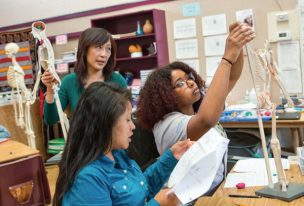The Complex Work of Figuring Out What Students Know

Written by Carrie Wilson, Former Executive Director at Mills Teacher Scholars
After more than a decade of placing far too much emphasis on standardized test results, there is (finally) growing acknowledgement that standardized tests cannot be considered a reliable measure of what students know. The discussion is shifting to focus on formative assessments, which provide teachers with information that can actually shape instruction and change the learning opportunities for their students.
However, in school districts’ drive towards common formative assessments, there is risk of over-simplifying, yet again, what it means for a teacher to understand student learning – the commonly assumed purpose of formative assessment. We rarely hear new ideas about what is actually involved for a teacher or a team of teachers to create and analyze assessments that provide information about student understanding. Perhaps even less likely is to hear if and how teachers communicate those results in a meaningful way to students and, eventually, to families and administrators.
Last week I received an email message from Tracey, one of the teacher scholars I work with through the Mills Teacher Scholars, a teacher learning program of the Mills School of Education. Her message highlights the work of using formative assessment data to inform instruction. Over the course of the school year Tracey has been working with her colleagues in our monthly meetings at her school-site to understand what independent reading should look like for her Kindergarten students—particularly those who struggle to settle in and engage with their books. Tracey’s school is in its second year of implementing a reading curriculum that relies heavily on kids finding “just right books” and spending a significant amount of time in their school day using those books for multiple purposes.
In a classroom of 21 five- and six-year-olds, it was hard for Tracey to keep track of what individual students were doing (and were not doing) during independent reading time. She did know that there were a few students who were struggling to engage with the text independently. As part of her Mills Teacher Scholars inquiry project she decided to video tape these focal students during reading time in a systematic way so that she could understand what was and was not happening. For the past few months, Tracey has been watching these videos with colleagues, trying to use these video data to come up with ways to support her students to better engage with their books.
In her recent e-mail she writes:
I have to tell you that my focal student had a real breakthrough during Independent Reading today. Last night, I was watching a 12-minute video of him during the Private Reading portion of Independent Reading. He had his eyes on print for a total of about 1 minute. Then I watched him with his partner in Partner Reading, same thing. They did not read one book together. Of course, it was very disheartening to see, but the reason I am doing this work, right?
Both Tracey’s close look at what is happening in her class through the use of video data and her willingness to face what is not happening, even if it is disappointing, are essential features in her quest to understand her students’ learning. Looking closely and acknowledging what her students are and are not able to do, rather than discussing the intentions of the lesson or framing the problem as a student deficiency (a common responses in this high stakes/pacing guide-driven world of public education) opens the door to meeting her students where they are and appropriately planning for where they will go next.
Tracey continues in her e-mail, sharing what she did with one of her focal students, after the Mills Teacher Scholars meeting at her school site.
This morning before school started, I showed him the “movie” I made of him and we talked about how his eyes were hardly ever on the book. We completed the Kindergarten version of a goal setting sheet…. (I made it yesterday immediately after our Mills Teacher Scholars meeting.) We also set a goal for him to keep his eyes on his book during Private Reading. I told him that I would make another movie of him and we would watch it to see if he reached his goal.
Tracey pulled both of her focal students aside and they watched a short clip of the day’s recordings. She writes that
We then made an assessment of whether or not they reached their goal based on the rubric on the goal sheet. Everybody saw that they both reached Superhero status and they were both thrilled! I cannot believe how motivating this was for both of them. You can really see it in the video. I’m especially excited to see if this motivation will be sustained by continual use of the goal sheet (without looking at the videos each time) and how I can bring this to the entire class without it being too time consuming.
In getting more clear about what her students are doing during private reading and about which element to focus on with these students—in this case eyes on text—Tracey is able to enter a partnership with her students where the students can take an active role in their learning. On one level, the goal chart serves as a formative assessment of their independent reading progress; but it is the video data that give Tracey the information she needs to present a goal sheet in a way that would precisely address the needs of these particular focal students.
Tracey’s story provides an example of the multiple steps a teacher takes in using formative assessments to determine what her students know. As a community interested in improving learning outcomes for all children—especially those children who struggle in school—let’s find more ways to support teachers as they develop the skills required to plan and implement formative assessment.

